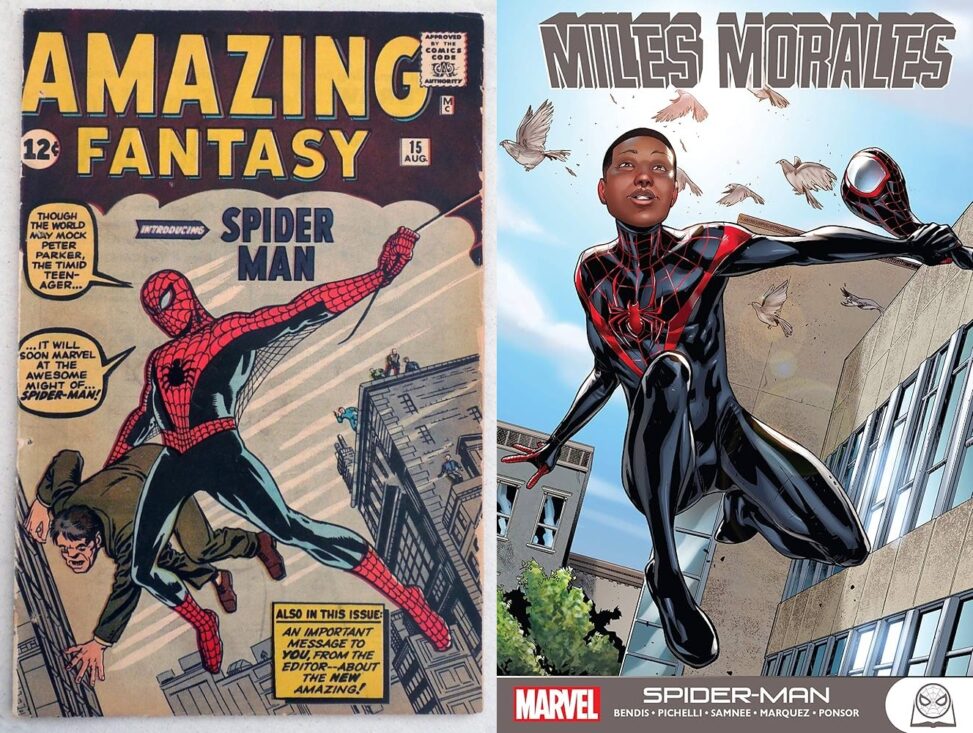Since his debut in 1962, Spider-Man has become one of the most iconic superheroes in pop culture. Created by Stan Lee and Steve Ditko, the original Spider-Man, represented the everyday teenager. Juggling personal responsibility, family, and school all while being a superhero. In 2011 Marvel introduced a new version of Spider-Man, Miles Morales, a mixed Afro-Latino teen from Brooklyn. Marking a significant shift in the cultural representation of the character.
Peter Parker’s Spider-Man was quite the product of its time, showing him as a typical American teen of the 1960s. Created during the “Silver Age” of comics, Peter’s character centered around the complicated time of being a teenager: school, romance, work, family, and being a superhero. His struggles were always personal, when his Uncle Ben died, he told Peter the classic quote of “With great power comes great responsibility” to remind him that he has a moral duty with his powers. Making him a relatable figure for readers especially young, white, and middle class (Brown, 2023). Peters bright red and blue costume became instantly recognizable, along with his storylines that mixed in personal desire and real issues in society, he was visually and narratively the marginalized mainstream superhero for his time.
In contrast, Miles’s new introduction The Marvel hero verse was the shift in how the character and the world around him was portrayed. Created by Brian Micheal Bendis and Sara Pichelli, bringing realities of urban life and racial identity into the pages of comic books. This shift was the departure of the Spider-Man that a majority of people grew up with. Unlike Peter whose identity is never questioned in any of his storylines, Miles’s racial and cultural identity is a key part of his character development other than being a superhero. As Jeffery A. Brown notes, Spider-man: Into the Spider-Verse (2018) highlights the significance of Miles’s background and how it shapes his world and experiences as a superhero (Brown, 2023). The film and comics always acknowledge the issues of Miles’s race, class, and representation. Making him more complex and interesting, it’s not just about him harnessing powers and going through the motions as a superhero. As Mario Worlds and Henry “Cody” Miller said, Miles’s racial identity makes the readers and viewers reconsider the traditional superhero character: that being white and male that has historically dominated the superhero genre for decades (Worlds and Miller, 2020).
Miles’s introduction also touches on the broader trends of media representation, marginalized characters are being bought to the center of mainstream media. Regina Mills argues, Miles is a “post soul” hero, with his complexities of being black in America. In light of major movements such as Black Lives Matter (Mills, 2022). His character relates to younger, diverse audience, that audience often sees themselves reflected in his story.
Not limited to visual representation. Miles’s experiences as an Afro-Latino man navigating the responsibilities of growing up and being Spider-Man in a racially layered society are the selling points of his character. Fredrick Luis Aldama suggests, characters like Miles are a part of a broader movement in Marvels storytelling, legacy characters are revamped to show issues of race, gender, and ethnicity (Aldama, 2017). This way, Miles’s storylines often touch on many societal concerns such as: police violence, systematic racism, and gentrification. Only a handful of issues that were never present in any of Peter Parkers narratives, in comics, movies, and tv shows.
The visual and narrative differences between Peter and Miles also reflect the cultural shift. Peters red and blue suit, symbolizing his connection to being a traditional American hero for kids and teens alike. Contrasts with Miles black and red suit. Different from the norm and what it means to be Spider-Man. Miles also being from a rougher part of town in Brooklyn than urban Queens like Peter shows the difference in life experiences between them. Following up, the structure of Spider-Man into the Spider-Verse presents Miles as a hero who has to step out of Peters shadow and make his own name; this was easier said than done seeing that he was different from the norm. The films slogan of “Anyone can wear the mask” emphasizes the incisiveness of the character and knocking the idea that being a hero is confined to one identity or race (Thomas, 2020)
The shift from Peter Parker to Miles Morales represents an evolution in the portrayal of superheroes in movies and comic books. Peter Parker being the product of his time, the experiences that related to a mainly white, middle-class audience, Miles Morales brings a fresh perspective that addresses the complex subjects of race, identity, and cultural representation in the 21st century. As media continues to evolve, Miles Morales shows the power of moving marginalized aspects from the center of mainstream pop culture. Displaying the demand for diversity in media.
Bibliography
Brown, Jeffrey A. “Anyone Can Wear the Mask”: The Marginalization of Miles Morales in Spider-Man: Into the Spider-Verse. MUSE, 2023.
Thomas, Tracey. “Let’s Do This One Last Time: Character, Adaptation, and Nostalgia in Spider-Man: Into the Spider-Verse.” Academia, 2020.
Worlds, Mario, and Henry “Cody” Miller. “Miles Morales: Spider-Man and Reimagining the Canon for Racial Justice.” Washcoll Review, 2020.
Mills, Regina Marie. “A Post-Soul Spider-Man: The Remixed Heroics of Miles Morales.” ResearchGate, 2022.
Aldama, Frederick Luis. “The Replacements: Ethnicity, Gender, and Legacy in Marvel Comics.” OUP, 2017.


Provide Feedback